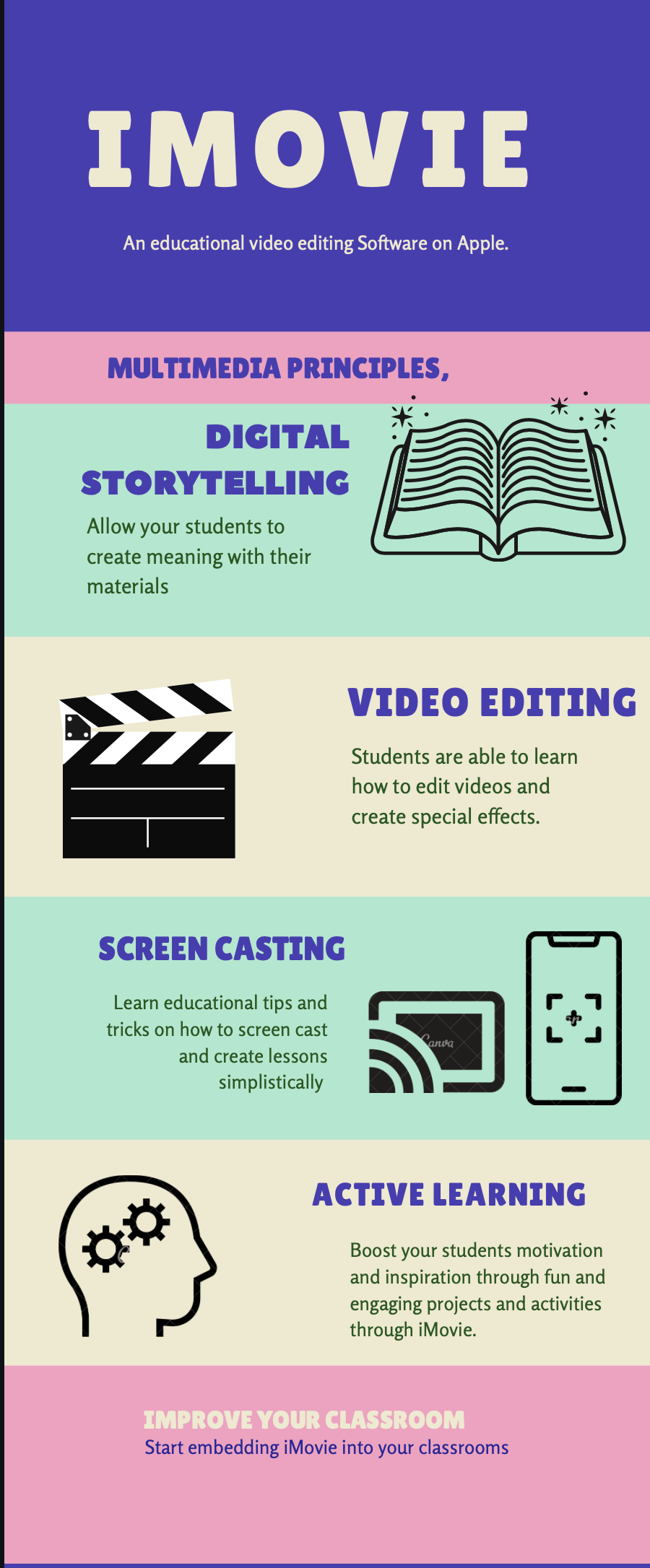By, Ramneet Buhllar & Molly Cunningham
Introduction to iMovie Software
- Introduction:
IMovie is a versatile source that allows students, teachers, and families the opportunity to use video as a means of expression and work completion. This learning content is directed towards teachers adapting towards multimedia project based assignments and allowing for more digital storytelling and video editing projects.
- Learning Outcomes:
By the end of this IMovie Multimedia Project you should be able to understand:
- The overview and basics of the iMovie software.
- How to insert and edit video/audio clips.
- The learning theories surrounding digital storytelling.
- How to implement iMovie into a classroom setting for storytelling projects and screencasting ideas.
- Educational outlook
Taking an educational outlook on this assignment, I remember becoming frustrated with how to edit videos during personal projects. Thus, our intention of this design was to provide students and teachers with a basic understanding in video editing software, so future classrooms could offer projects and assignments that utilize technology.
Inspired by topic 4, Multimedia Design for Learning, our idea formed once we learned about digital storytelling and how to create screencasting videos. Therefore, we both researched how to use iMovie (both Apple users) and how to effectively edit videos. We also wanted to include a digital story within the video itself, our script is intended to be humorous for students to easily understand and follow along. In addition, our video is available for anyone looking to expand their knowledge of iMovie, however a classroom was our intentional audience.
- Filming and Editing (Project Plan)
To create our original content (posted below) we worked together to create a fun script and brainstormed the most essential tools for creating videos. We also embedded a screencast and presentation to utilize our understanding of multimedia principles. We both worked together to create a script, and Molly decided to act and film while Ramneet focused on learning theories and implementing them into classrooms. Overall, we wanted to find the most advantageous way of creating a user-friendly resource for encouraging teachers to implement multimedia principles within their classroom.
Instructional Videos (Original Content):
These videos encourage students to understand the potential of digital storytelling and video editing software. Watching these in a classroom is a great way to begin your understanding of iMovie and its purpose within the classroom.
Ashley Fells on TED Talk:
This is the link to our original content for this multimedia assignment.
Discussion:
Upon researching, experimenting, and exploring multimedia through this class I believe that iMovie could be a great resource for teachers to make use of multimedia principles (Mayer, 2019). Teachers are able to embed the software into their own lectures or students’ projects and activities. For example, a class discussion; there are many students who may not feel comfortable, or be able to partake in some activities. The teacher could utilize iMovie by incorporating several videos of the lesson process and then insert helpful commentary slides to guide the digital experience. Further, teachers’ use of iMovie could introduce students to initial video editing software. For example, for this multimedia design project we have incorporated an iMovie on how to use iMovie. The possibilities are endless as long as one has the ability to take photos and videos and import to Apple technology (iPads, iPhones or computers).
Learning Theories
A major theory that was implemented throughout the entirety of this project was multimedia learning theory and dual-code theory. Dual code theory proposes the use of both visual and verbal processing to present information to learners. This was depicted through firstly uploading on Youtube to allow visual Captions (CC) and visualizations also our use of the screencast tool and utilizing voiceovers (voice principle) during the presentation to aid learning via step-by-step (temporal contiguity principle). Rather than using static images, we chose to incorporate screencasting in our presentation as this encourages learners to follow along with the video rather than tools like PowerPoint where learners would often need to search for specific tools while watching PowerPoints. This creates a better storytelling experience for learners especially when learning multimedia tools as viewers become learners, while also being able to control their pace of learning (segmented principle) rather than having to view one continuous video that overloads the cognitive load capacity of learners. We also chose to introduce some key components within iMovie prior to delving into the instructional material so that learners without prior knowledge of the software can become more familiar with the interface of iMovie and tools in iMovie we use throughout our video, this process began around the 0.44 second mark (pre-training principle).
Overview
This project is intended as an educational resource for teachers or students to provide classrooms with integrated multimedia principles. Students will learn the basics of video editing along with some fun special effects to improve their skills. Teachers are able to evaluate students on their ability to create digital stories and their level of video editing. In the future, I believe that creating a resource that is more user friendly would be ideal for teachers, as Apple products are limited and iMovie is not available on other projects. Overall, our multimedia activity aims at integrating teachers multimedia toolset and increasing the level of technological support to develop students’ learning potential.
References:
Mayer, Richard E. “Cognitive Theory of Multimedia Learning.” The Cambridge Handbook of Multimedia Learning. Ed. Richard E.Mayer. Cambridge: Cambridge UP, 2014. 43-71. Print. Cambridge Handbooks in Psychology.
Mayer, Richard E., and Logan Fiorella. “Principles for Reducing Extraneous Processing in Multimedia Learning: Coherence, Signaling, Redundancy, Spatial Contiguity, and Temporal Contiguity Principles.” The Cambridge Handbook of Multimedia Learning.Ed. Richard E. Mayer. Cambridge: Cambridge UP, 2014. 279-315. Print. Cambridge Handbooks in Psychology.
Fell, A. (2017). Why Storytelling is so Powerful in the Digital Era [Video]. TEDx Talks. Retrieved from https://www.youtube.com/watch?v=mSi0kmqOBu4&t=866s
Lynch, M. (2017, November 7). How Digital Storytelling Can Amplify Your Students’ Voices. Retrieved November 14, 2017


